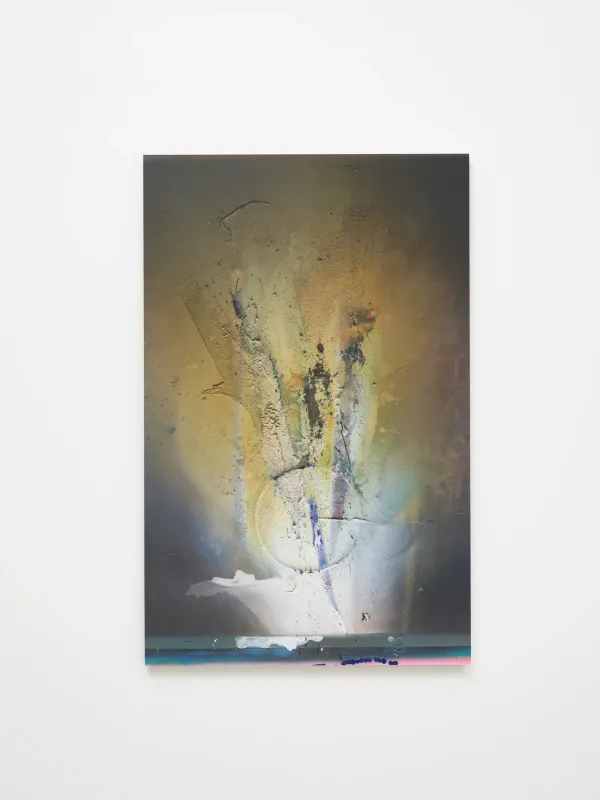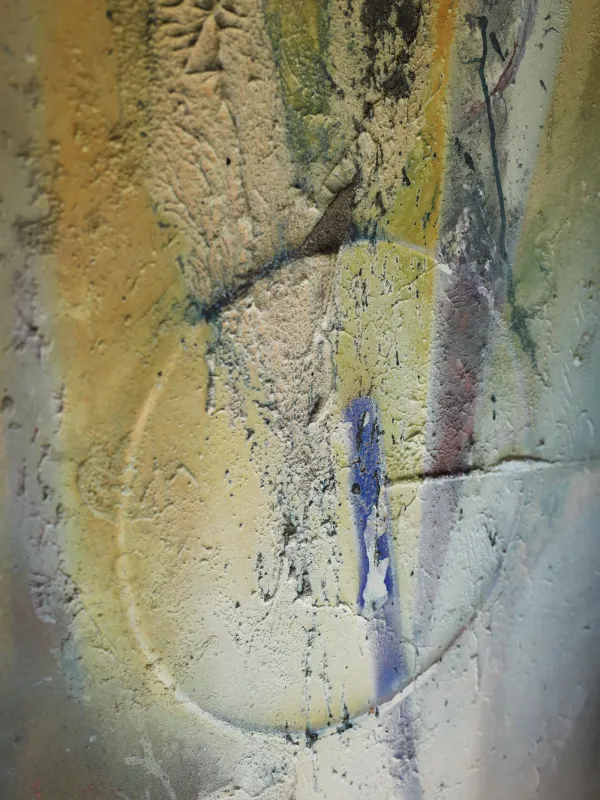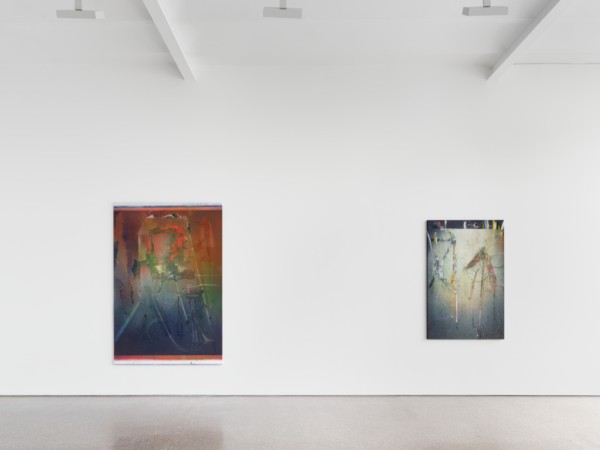
Liam Everett Untitled (the bow), 2023 Ink, oil, sand on linen 147 x 94 cm 57 7/8 x 37 1/8 inches Galerie Greta Meert
Galerie Greta Meert is pleased to present He Loved Him Madly, a new series by Liam Everett. In this exhibition, Everett advances his sustained investigation into painting as a cumulative and exploratory process — one rooted in impermanence, flux, and the lingering trace of action.
His works do not offer fixed images; instead, they hold the layered memory of movement, erasure, and resistance, shaped over time.
The exhibition title references Miles Davis’s 1974 composition, a haunting elegy for Duke Ellington. Rather than adhering to traditional structure,
Davis’s piece unfolds through drift, repetition, long pauses, and improvisation, evolving without closure. This sensibility mirrors Everett’s approach: like Davis, he cultivates delay, disappearance, and gradual revelation.
The title becomes more than quotation; it frames Everett’s devotion to a form of painting that remains elusive, unstable, and persistently alive.
Central to the show are large circular canvases — tondos spanning roughly 165 to 195 cm — accompanied by smaller works.
These paintings evolve not through direct depiction but through accumulation and removal. Pigment, alcohol, salt, and solvents are repeatedly applied and stripped away, creating luminous, weathered surfaces that feel both mineral and atmospheric. Painting here becomes a cycle of erasure and renewal; disappearance is as essential as mark-making, keeping the image in a perpetual state of emergence and dissolution.
Everett’s methodology positions his practice close to performance.
Each surface retains gestures — pressures, rubbings, cancellations — more as memory than as mark.
What remains visible is not a singular stroke but the energy of repeated acts, layered until the canvas becomes a recording of time passed.
These works unfold slowly, shifting with light, viewpoint, and duration. They invite a patient, durational form of looking in which the painting behaves almost like a performance held in suspension.
His titles — poetic, enigmatic, and suggestive — extend this mystery. Works such as Ra folding, nazar se, or not a sound, only the embers act not as explanations but quiet signals, deepening the paintings’ atmospheric presence.

Everett resists stable meaning; instead, he draws viewers into a phenomenological encounter where perception, memory, and body interact with surfaces that flicker and shift.
The reference to Davis reinforces the connection between painting, time, and sound.
Both artists work through repetition and variation, silence and erasure, duration and delay.
Just as Davis carved out an expansive space for mourning without resolution, Everett sustains a delicate balance between appearance and vanishing.
The tondo form intensifies this sensation of hovering. Circular yet unanchored, the paintings evoke celestial objects or archaeological relics, while their textures remain vulnerable, vibrating with fragility.

Liam Everett Untitled (one from another), 2025 Ink, oil, sand on linen 89 x 201 cm 35 1/8 x 79 1/4 inches Galerie Greta Meert
Majestic in scale but sensitive in presence, they do not claim authority; instead, they invite contemplation and linger at the threshold of becoming.
Everett’s practice embraces contradiction: painting that is at once emphatic and fleeting, materially driven yet guided by memory and gesture.
He Loved Him Madly positions each work not as a concluding statement but as an echo — a site where action, process, and language converge, and where painting persists as a living, unresolved, and continuously unfolding practice.
Through cycles of erasure, layered gesture, poetic titling, and an ongoing dialogue with Miles Davis, Everett presents painting as endurance and devotion — an open field where presence meets absence, and where each act of looking reactivates the work.
His canvases offer not certainty but reverberation, a space in which gesture remains as echo and painting performs itself again and again in time.
Liam Everett (b.1973, Rochester, NY) approaches abstraction through a physical, almost combative process, producing works that move fluidly between mark-driven traces and independent painterly forms.
In Liam Everett 's mixed-media paintings and sculptures, Everett treats art-making as an embodied act, using movement to transform raw materials into resolved compositions.
Influenced by dance and theatre, Liam Everett works carry visible evidence of presence and motion—gestural marks, smudges, lines, and folds.
Liam Everett often removes layers of pigment with ordinary yet corrosive substances such as salt, lemon juice, and alcohol, revealing the material weight of the surface and suggesting a process akin to alchemy.
Over the past three decades, Galerie Greta Meert has become a defining presence in Brussels’ contemporary art scene.
Established in 1988 under the name Galerie Meert Rihoux and renamed in 2006 to honor founder Greta Meert, the gallery is housed in a five-story Art Nouveau building in central Brussels.

Originally designed by Louis Bral and later refurbished by acclaimed Belgian architects Hilde Daem and Paul Robbrecht, the space now dedicates three floors to exhibitions, allowing for an ambitious and varied programming schedule since 2012.
The gallery launched with Thomas Struth’s first major international exhibition, followed by important early presentations of Robert Mangold, Richard Tuttle, Louise Lawler, John Baldessari, and Hanne Darboven.
In 1992, the gallery showcased early sculptural works by Isa Genzken and initiated its long-standing engagement with Donald Judd.
These foundational exhibitions reflect the gallery’s early commitment to championing groundbreaking artists who had yet to gain wide recognition in Belgium.
From the outset, Galerie Greta Meert has placed strong emphasis on Minimalism and Conceptual art, as well as the role of photography within conceptual practices.
As early as 1991, it was among the first European galleries to exhibit key figures of the Vancouver School, including Ian Wallace, Jeff Wall, and Ken Lum.
Throughout the 1990s and early 2000s, the gallery expanded its program, presenting artists such as Carl Andre, Robert Barry, Jef Geys, Peter Joseph, Shirley Jaffe, Sol LeWitt, Jean-Luc Moulène, Fred Sandback, Niele Toroni, Didier Vermeiren, and Michael Venezia.
In parallel, the gallery contributed to renewed international attention toward mid-20th-century Italian artists who had been overshadowed by Arte Povera, including Carla Accardi, Gianfranco Baruchello, Enrico Castellani, and Mimmo Jodice.

More recently, Galerie Greta Meert has continued to build on its historical identity by working with a younger generation of Belgian and international artists.
These include Eric Baudelaire, Katinka Bock, Iñaki Bonillas, Nathalie Du Pasquier, Liam Everett, Johannes Esper, Valerie Krause, Anne Neukamp, Magali Reus, and Johannes Wald, alongside Belgian artists Edith Dekyndt, Sophie Nys, Koen Van den Broek, Catharina van Eetvelde, and Pieter Vermeersch.